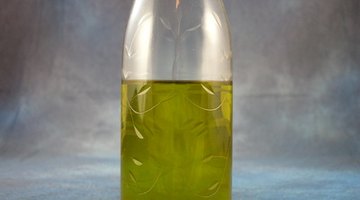How to Safely Remove Paint or Glue From Plastics
Paint and glue are similar in that they both contain powerful adhesives formulated to help them bond to hard, non-porous surfaces. Unfortunately, these qualities make them both very difficult to remove.

When it comes to removing paint or glue from plastics, there is a delicate balance between breaking down the adhesive chemicals and not damaging the very surface you are trying to save.
Things You Will Need
- Olive oil
- Turpentine
- Rags
- Plastic putty knife
- Mineral spirits
Tip
As an alternative step for paint only, apply a few drops of olive oil to the paint you want to remove. Allow the oil to sit for two minutes. Wrap a rag around a plastic putty knife to act as a buffer between the plastic surface and the putty knife. This will help prevent unintentional scratches and abrasions. Then scrape away the paint using the wrapped, plastic putty knife. Plastic putty knives offer a good balance of rigidity and flexibility to help prevent unintentional damage to plastics. Never use a metallic putty knife in place of a plastic one or you may scar the surface.
Warning
Do not use harsh chemicals on plastic as they can damage the surface. In addition, they can cause paint and glue to melt, further bonding them to the plastic.
Do not allow the mineral spirits to soak for longer than twenty seconds or you may risk damage to the plastic.
Do not use a coarse brush on the paint or glue as this can cause abrasions in the plastic.
Removing paint or glue from plastic
-
Dampen a rag with turpentine. Apply the turpentine to the glue or paint that you want to remove, and allow it to soak for two minutes.
-
Wipe away the glue or paint using a clean, dry rag. If any glue or paint remains on the plastic, dampen a new rag with mineral spirits. Apply the spirits to the remaining glue or paint, and allow it to soak for twenty seconds.
-
Scrape away the paint using a plastic putty knife. Wrap a rag around the plastic knife to act as a buffer between the plastic surface and the putty knife. This will help prevent unintentional scratches and abrasions.
-
Wipe away any mineral spirits that have not evaporated with a fresh, clean, dry rag.
The Drip Cap
- Paint and glue are similar in that they both contain powerful adhesives formulated to help them bond to hard, non-porous surfaces.
- Apply the turpentine to the glue or paint that you want to remove, and allow it to soak for two minutes.
Writer Bio
Ryan Lawrence is a freelance writer based in Boulder, Colorado. He has been writing professionally since 1999. He has 10 years of experience as a professional painting contractor. Lawrence writes for High Class Blogs and Yodle. He has a bachelor's degree in journalism and public relations with a minor in history from the University of Oklahoma.
Photo Credits
- olive oil in bottle image by jimcox40 from Fotolia.com
- olive oil in bottle image by jimcox40 from Fotolia.com
More Articles



